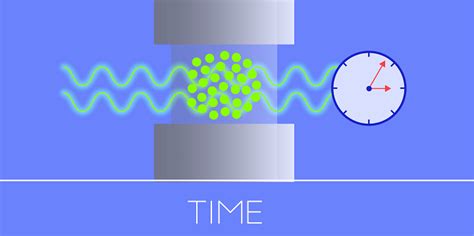The quest for precision in time measurement has been a longstanding one, with each passing era bringing forth innovations that redefine our understanding of time itself. From the ancient sundials to the modern atomic clocks, the evolution of time measurement has been a testament to human ingenuity and the pursuit of accuracy. In recent years, the field of time measurement has witnessed a significant leap forward, with the advent of cutting-edge technologies that have redefined the boundaries of precision.
Time measurement is no longer just about telling the time; it has become an intricate dance of scientific precision, technological innovation, and practical application. The latest advancements in time measurement have far-reaching implications, impacting various fields such as physics, engineering, navigation, and even our daily lives. As we delve into the world of high-tech time measurement, we will explore the latest developments, their significance, and the impact they have on our understanding of time.
Atomic Clocks: The Pinnacle of Precision

Atomic clocks are widely regarded as the most accurate timekeeping devices in the world. These clocks use the vibrations of atoms to measure time, with an error margin of just one second over tens of millions of years. The latest generation of atomic clocks, such as the National Institute of Standards and Technology (NIST) atomic clock, has achieved an unprecedented level of precision, with an error margin of just 0.0000000003 seconds per year.
The NIST atomic clock uses a novel approach called the "optical lattice clock," which involves trapping atoms in a lattice of light and measuring their vibrations. This approach has enabled the clock to achieve an unprecedented level of precision, making it an essential tool for scientific research and timekeeping applications.
Benefits of Atomic Clocks
The precision of atomic clocks has far-reaching implications for various fields, including:
- Scientific research: Atomic clocks enable scientists to make precise measurements of physical phenomena, such as the speed of light and the fundamental constants of nature.
- Navigation: Atomic clocks are used in GPS systems to provide location and time information, enabling accurate navigation and mapping.
- Telecommunications: Atomic clocks are used to synchronize clocks in telecommunications networks, ensuring accurate timekeeping and data transmission.
Quantum Clocks: The Next Frontier

Quantum clocks represent the next frontier in time measurement, with the potential to surpass the precision of atomic clocks. These clocks use the principles of quantum mechanics to measure time, exploiting the strange and counterintuitive behavior of particles at the quantum level.
Quantum clocks have the potential to achieve an even higher level of precision than atomic clocks, with some estimates suggesting an error margin of just 0.00000000001 seconds per year. While still in the early stages of development, quantum clocks promise to revolutionize our understanding of time and its measurement.
Challenges and Opportunities
The development of quantum clocks faces several challenges, including:
- Noise reduction: Quantum clocks are highly sensitive to noise, which can degrade their precision.
- Scalability: Quantum clocks are currently small-scale devices, and scaling them up to larger sizes while maintaining precision is a significant challenge.
Despite these challenges, quantum clocks offer significant opportunities for advancing our understanding of time and its measurement. Researchers are actively exploring new techniques and technologies to overcome the challenges and unlock the full potential of quantum clocks.
Optical Clocks: A New Generation of Timekeeping

Optical clocks represent a new generation of timekeeping devices, using light to measure time instead of traditional mechanical or electrical signals. These clocks have the potential to achieve an even higher level of precision than atomic clocks, with some estimates suggesting an error margin of just 0.0000000001 seconds per year.
Optical clocks use a novel approach called the "optical comb," which involves generating a series of equally spaced spectral lines using a laser. This approach enables the clock to achieve an unprecedented level of precision, making it an attractive alternative to atomic clocks.
Advantages of Optical Clocks
Optical clocks offer several advantages over traditional timekeeping devices, including:
- Higher precision: Optical clocks have the potential to achieve an even higher level of precision than atomic clocks.
- Smaller size: Optical clocks are smaller and more compact than atomic clocks, making them easier to integrate into existing systems.
- Lower power consumption: Optical clocks consume less power than atomic clocks, making them more energy-efficient.
Conclusion: Redefining the Boundaries of Precision
The evolution of time measurement has come a long way, from the ancient sundials to the modern atomic clocks. The latest advancements in time measurement, including atomic clocks, quantum clocks, and optical clocks, have redefined the boundaries of precision and accuracy. As we continue to push the boundaries of what is possible, we may uncover new and exciting applications for these technologies, from scientific research to everyday life.
The future of time measurement holds much promise, with ongoing research and development aimed at achieving even higher levels of precision and accuracy. As we look to the future, one thing is certain: the quest for precision in time measurement will continue to drive innovation and discovery, redefining our understanding of time and its role in our lives.






What is the most accurate timekeeping device in the world?
+The most accurate timekeeping device in the world is the atomic clock, which uses the vibrations of atoms to measure time with an error margin of just one second over tens of millions of years.
What is the difference between atomic clocks and quantum clocks?
+Atomic clocks use the vibrations of atoms to measure time, while quantum clocks use the principles of quantum mechanics to measure time. Quantum clocks have the potential to achieve an even higher level of precision than atomic clocks.
What are the benefits of optical clocks?
+Optical clocks offer several benefits, including higher precision, smaller size, and lower power consumption compared to atomic clocks.
